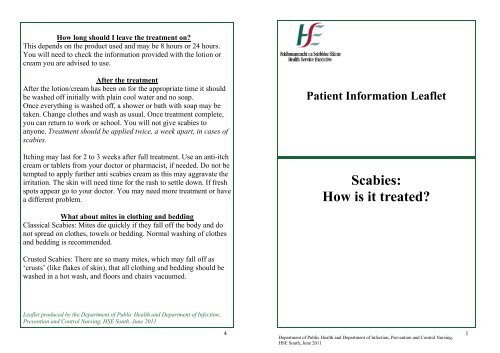Scabies: How is it treated? Patient Information Leaflet
Scabies: How is it treated? Patient Information Leaflet
Scabies: How is it treated? Patient Information Leaflet
Create successful ePaper yourself
Turn your PDF publications into a flip-book with our unique Google optimized e-Paper software.
<strong>How</strong> long should I leave the treatment on?<br />
Th<strong>is</strong> depends on the product used and may be 8 hours or 24 hours.<br />
You will need to check the information provided w<strong>it</strong>h the lotion or<br />
cream you are adv<strong>is</strong>ed to use.<br />
After the treatment<br />
After the lotion/cream has been on for the appropriate time <strong>it</strong> should<br />
be washed off in<strong>it</strong>ially w<strong>it</strong>h plain cool water and no soap.<br />
Once everything <strong>is</strong> washed off, a shower or bath w<strong>it</strong>h soap may be<br />
taken. Change clothes and wash as usual. Once treatment complete,<br />
you can return to work or school. You will not give scabies to<br />
anyone. Treatment should be applied twice, a week apart, in cases of<br />
scabies.<br />
Itching may last for 2 to 3 weeks after full treatment. Use an anti-<strong>it</strong>ch<br />
cream or tablets from your doctor or pharmac<strong>is</strong>t, if needed. Do not be<br />
tempted to apply further anti scabies cream as th<strong>is</strong> may aggravate the<br />
irr<strong>it</strong>ation. The skin will need time for the rash to settle down. If fresh<br />
spots appear go to your doctor. You may need more treatment or have<br />
a different problem.<br />
What about m<strong>it</strong>es in clothing and bedding<br />
Classical <strong>Scabies</strong>: M<strong>it</strong>es die quickly if they fall off the body and do<br />
not spread on clothes, towels or bedding. Normal washing of clothes<br />
and bedding <strong>is</strong> recommended.<br />
Crusted <strong>Scabies</strong>: There are so many m<strong>it</strong>es, which may fall off as<br />
‘crusts’ (like flakes of skin), that all clothing and bedding should be<br />
washed in a hot wash, and floors and chairs vacuumed.<br />
<strong>Leaflet</strong> produced by the Department of Public Health and Department of Infection,<br />
Prevention and Control Nursing, HSE South, June 2011<br />
4<br />
<strong>Patient</strong> <strong>Information</strong> <strong>Leaflet</strong><br />
<strong>Scabies</strong>:<br />
<strong>How</strong> <strong>is</strong> <strong>it</strong> <strong>treated</strong>?<br />
Department of Public Health and Department of Infection, Prevention and Control Nursing,<br />
HSE South, June 2011<br />
1
<strong>How</strong> <strong>is</strong> <strong>it</strong> <strong>treated</strong>?<br />
<strong>Scabies</strong> <strong>is</strong> <strong>treated</strong> w<strong>it</strong>h a lotion or cream. You can buy <strong>it</strong> from a<br />
chem<strong>is</strong>t w<strong>it</strong>hout a prescription, but <strong>it</strong> <strong>is</strong> better to see your doctor first.<br />
The treatment most commonly used (permethrin) <strong>is</strong> recommended to<br />
be applied twice, one week apart. Everyone should be <strong>treated</strong> at the<br />
same time so the m<strong>it</strong>es do not pass back to a <strong>treated</strong> person.<br />
Who needs treatment?<br />
Everyone who has scabies needs 2 treatments, one week apart.<br />
Everyone who has had skin contact w<strong>it</strong>h someone w<strong>it</strong>h scabies for<br />
more than 5-10 minutes, e.g. partner, boyfriend, girlfriend, children,<br />
household contacts etc, need to be <strong>treated</strong>. Even those w<strong>it</strong>h no rash or<br />
<strong>it</strong>ch, should have at least 1 treatment.<br />
Putting on the lotion or cream<br />
The treatment may be best applied at night. Take off all your clothes.<br />
Take off watches and rings. If <strong>it</strong> <strong>is</strong> not possible to remove a ring,<br />
move <strong>it</strong> to one side to treat the skin surface underneath.<br />
Do not have a hot bath or shower before putting on the cream.<br />
<strong>How</strong>ever, do ensure that skin <strong>is</strong> clean, dry and cool.<br />
Squeeze the cream/lotion into your palm.<br />
Cream/lotion should be applied to the whole body below the jaw line,<br />
according to manufacturer's instructions.<br />
In some cases, the treatment may need to extend to the scalp, neck,<br />
face and ears. Th<strong>is</strong> includes infants, children up to age two, the<br />
elderly, the immunocomprom<strong>is</strong>ed, and those whose treatment has<br />
failed. Check w<strong>it</strong>h your doctor if th<strong>is</strong> may apply to you or your<br />
family. If the treatment <strong>is</strong> to be applied to the head, avoid the eyes<br />
and in young children the mouth area, where the cream/lotion may be<br />
licked off.<br />
Department of Public Health and Department of Infection, Prevention and Control Nursing,<br />
HSE South, June 2011<br />
2<br />
Take special care to get <strong>it</strong> into the skin creases of the body – for<br />
instance, nipples and gen<strong>it</strong>alia. Particular attention needs to be paid<br />
to the skin between the fingers and toes, under the nails and behind<br />
the ears. You will need someone else to apply lotion to your back.<br />
Brush some cream/lotion under the nails w<strong>it</strong>h a soft nail brush as<br />
m<strong>it</strong>es can easily escape treatment in the thickened skin there. Nails<br />
should be trimmed and kept short for duration of treatment.<br />
Let the cream/lotion dry before getting dressed or <strong>it</strong> may rub off<br />
(th<strong>is</strong> takes 10-15 minutes).<br />
Do the soles of your feet last after the body treatment has dried. Th<strong>is</strong><br />
<strong>is</strong> best done w<strong>it</strong>h your feet resting on top of or dangling over the<br />
side of the bed. Put more cream/lotion on any parts you wash during<br />
the treatment period, e.g. hands or skin after changing nappies or<br />
incontinence wear while the lotion/cream <strong>is</strong> on the body. If you need<br />
to wash your hands often, use plastic gloves for dirty work during<br />
the treatment period.<br />
Pay special attention to these areas when you put on the lotion<br />
or cream:<br />
Behind both ears<br />
Both armp<strong>it</strong>s<br />
Underneath breasts<br />
Naval<br />
Between fingers<br />
and under finger nails<br />
Groin and gen<strong>it</strong>al area<br />
between the legs<br />
Back of knees<br />
Between all toes Soles of feet<br />
And under nails<br />
Department of Public Health and Department of Infection, Prevention and Control Nursing,<br />
HSE South, June 2011<br />
3






